Don't ask me why I'd watch the crappy little films of Kenneth Anger. Maybe it's only cuz of my soft spot for the topic history of homosexuality in the arts. That the was the reason I went to a little Ken Anger Film Festival many long years ago in a tiny theater in Seattle that later become Hugo House, a nerd-gathering place for would-be writers. With a crowd of faggots & a few dykes & fewer still ordinary film buffs, it was a great introduction to a filmmaker who is to say the least unusual.
Anger's films are short enough I get something out of them, whether more or less than was put into them is hard to say.
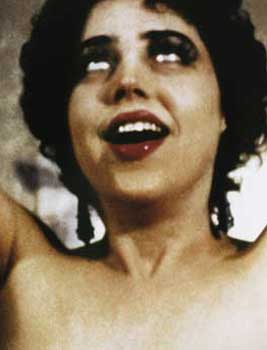 Puce Moment (1949) starts out as the story of flapping fabric of dresses. They should've been worn by Ken himself; who would've known with mostly close-ups of cloth. But eventually we get to see the dancer's face & legs & she's quite a beauty hopping about in her boudoir. Puce Moment (1949) starts out as the story of flapping fabric of dresses. They should've been worn by Ken himself; who would've known with mostly close-ups of cloth. But eventually we get to see the dancer's face & legs & she's quite a beauty hopping about in her boudoir.
She's Yvonne Marquis whose sole claim to fame appears to be that Kenneth Anger filmed her for lordy knows what reason, except I might've filmed her too if she happened by one day when I was screwing around mindlessly with camera equipment.
This is followed by Yvonne's drag-queeny I'm-so-sexy display in front of a mirror, turning into a fainting fit onto the bed. For a penultimate "climax" it turns out to be the roof of a building instead of a boudoir as seemed probable throughout. Lastly we get to see her in art decoish pose walking her wolfhounds in imitation of an old time movie star.
Puce Moment is really only a fragment of an abandoned film project, & just as well it was abandoned since it seems exactly the right length now. When the scant six minutes ends I felt I'd gotten six minutes of enjoyment out of the silly little thing.
This is exactly the sort of "famous" art film that makes amateurs enthuse they can do as good as that & so go out to make an even crummier film that can't entertain for six minutes.
Great about Puce Moment is the Jonathan Halper soundtrack that has been compared to Pink Floyd, but to me he sounds like Sean Lennon imitating his dad.
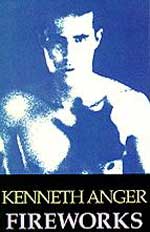 For Ken Anger Fireworks (1947) must pass as one of his "major works," at under a quarter-hour, filmed when he was a young spunk of seventeen. It is necessary to remember that date, 1947, which was long, long, long before Stonewall & Gay LIberation, to understand that Anger was a bold, brave, & pretty damned cool kid. For Ken Anger Fireworks (1947) must pass as one of his "major works," at under a quarter-hour, filmed when he was a young spunk of seventeen. It is necessary to remember that date, 1947, which was long, long, long before Stonewall & Gay LIberation, to understand that Anger was a bold, brave, & pretty damned cool kid.
His visual puns reveal that he was already aware of the works of Cocteau, who became a friend when Anger was in Paris as a sweet young thang, as opposed to the bitter old queen he'd already become by the 1960s randomly outing or picking on fat movie stars in order to soothe & satisfy his own self-loathing ego.
When this film was shown at the tiny coronet Film Society's theater, it was the queer party to end all queer parties of the era. Charles Laughton, Dr. Alfred Kinsey, James Whale, Bertolt Brecht... all eager to laud & should chance avail itself bugger the new film-poet fresh on the scene.
That doesn't necessarily mean Fireworks is any good, but it's historic, & if anything of the avant garde can ever be said to be more than a revamped dadaism thus only a big joke, then Ken Anger's work is more.
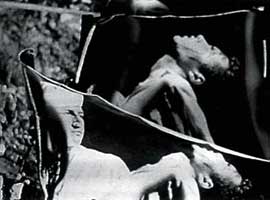 Anger casts himself as the horny young man who awakens from a dream or perhaps is still dreaming, & heads out on a violent quest for sexual satisfaction or achievement. Symbolism abounds like the doused torch that begins the film, the light seen in the men's can, as allusions to Lucifer not as Devil but as God of Enlightenment. Anger casts himself as the horny young man who awakens from a dream or perhaps is still dreaming, & heads out on a violent quest for sexual satisfaction or achievement. Symbolism abounds like the doused torch that begins the film, the light seen in the men's can, as allusions to Lucifer not as Devil but as God of Enlightenment.
The highlight of the piece most viewers will place long in memory is the lover with the fireworks spewing penis, at the climax (so to speak). But I found more interesting the March of the Sailors, which seemed strictly a masturbatory moment for Ken to show himself in private.
His fantasy of the homosexual as butch & barbaric is something that can be seen in any gay biker bar in America. It's a queer style that probably did begin with the high-gay-appeal actively bisexual Brando of the 1950s, was outed wholly by Anger in the 1960s, & has never since died down.
It's also the film that informed Scorsese that a soundtrack could be pieced together with pop tunes, & the mere fact that Scorsese bothered to go see a leather-fag film reveals how strangely seriously Kenneth Anger managed to be taken. So, never one of my favorites, Scorpion Rising is nevertheless one of Anger's more important films.
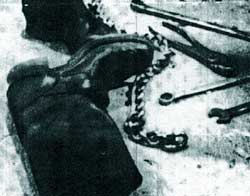 If you ever get a chance to see Scorpio Rising (1964) on its 16 mm print distributed mainly to campuses, do so, as it may be a while before it ever has a dvd, if it ever does. Anger had a bad habit of editing his films with pop tunes without bothering to get permission, & in this case the rights to coopted material would be prohibitively expensive. So if it is to be had on dvd at all, it'll have to be a pirated edition off an old vhs release, tapes old enough they're becoming unstable & not worth the going price.
If you ever get a chance to see Scorpio Rising (1964) on its 16 mm print distributed mainly to campuses, do so, as it may be a while before it ever has a dvd, if it ever does. Anger had a bad habit of editing his films with pop tunes without bothering to get permission, & in this case the rights to coopted material would be prohibitively expensive. So if it is to be had on dvd at all, it'll have to be a pirated edition off an old vhs release, tapes old enough they're becoming unstable & not worth the going price.
This is a distressing film, more substantive than a lot of Anger's films. If anyone were previously viewing his films under the delusion that he was a bit of a naif with his childish interest in Satanism, his unskilled but creative camerawork, & his daring revelations of his own sexuality, well, this one reveals a totally self-aware perv who doesn't just like old-timey sailor boy outfits & buff lads with hot rods, but is hot for nazi symbols & tough biker dudes &, if we hadn't already guessed it from his formative Fireworks, sadism.
While on one level it satirizes the Hell's Angels who I imagine would be livid over such a representation of motorcycle hoods, on another it is a completely honest recasting of the Marlon Brando character in The Wild One as Anger's personal & real fetish-fantasy, acted out for him by Bruce Byron, perhaps the only one of Anger's many "discoveries" who went on to have an authentic acting career.
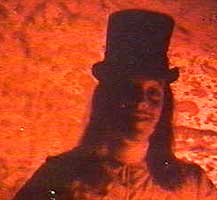 Beginning as a soft core porn short celebrating boy flesh, Invocation of My Demon Brother (1969) quickly turns into a parade of Satanic poofery. Everyone including the dog is getting stoned, & especially strange is sucking hash from the miniature skull.
Beginning as a soft core porn short celebrating boy flesh, Invocation of My Demon Brother (1969) quickly turns into a parade of Satanic poofery. Everyone including the dog is getting stoned, & especially strange is sucking hash from the miniature skull.
Crowleyesque rituals begin in a messy house no one had time to straighten up even knowing Kenneth would be filming that day. Just about everything is Anger's favorite color, red.
There are a handful cheezy tattoos & a very queeny sorcerer (Anger himself) & peculiar images of tortured Jesus, a nazi flag, & a grinning goofball Anger must've thought was sexy.
Short though it is, it seems interminable, & when Satan appears in person halfway through, he's just so silly looking in his cape & little horns. The fact that he's played by "the black pope" himself, Anton LaVey, scarcely lowers the silly bar.
When I'm told by film fans who dislike avant garde that Ken Anger is stupid, I assume this is the film they mean. In its favor, however, is the manner by which it functions as a warm-up of the vastly better Lucifer Rising (1972) which uses much the same thematic imagery but to a much more high-camp-poetic rather than merely silly effect.
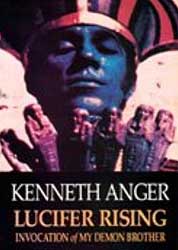 Apart from musical soundtrack, Lucifer Rising is again a silent film, paying extreme homage to Aleister Crowley, & being Ken Anger's most aesthetically refined vision of decadence. Apart from musical soundtrack, Lucifer Rising is again a silent film, paying extreme homage to Aleister Crowley, & being Ken Anger's most aesthetically refined vision of decadence.
Opening with a long volcanic sequence that is surprisingly calming for an inferno, we're soon to be taken on a pagan journey of menacing delights. The Goddess Isis (played with grand conviction by the absolutely stunning Miriam Gibril) watches a crocodile hatching & become a giant as she reposes languidly among the toppled ruins of gargantuan statuary.
Osiris (Anger's suicidal pal Donald Cammell who did eventually do himself in) appears among the ruins. Amidst eclipse of the sun & ritual, they raise Set aka Lucifer (Leslie Huggins) from the dead; or, rather, a young man awakens from the dream of Isis & sits up in the red room of his London apartment, clad in motley, later to be shown in the altogether.
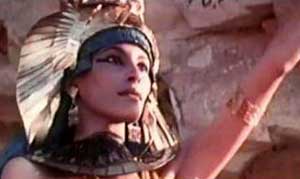 We observe this young man at sundry half-mundane half-supernatural activities, until he takes a bath, sinks beneath the tub's water, & seemingly awakens as an androgynous ghostly woman in a tomb in a burning forest. We observe this young man at sundry half-mundane half-supernatural activities, until he takes a bath, sinks beneath the tub's water, & seemingly awakens as an androgynous ghostly woman in a tomb in a burning forest.
Marianne Faithful (who had no positive feelings about having worked with Anger) plays this risen Lilith, who passes through caverns beneath a temperate druidic forest & comes out the other side into a completely different world, where the sorcerer (Anger) conjures & an elephant tramples a cobra.
On one level Lucifer Rising is a stoner's "gay club film" to be shown at 1970s discoteques, projected high on the wall while faggots & dykes dance together under a mirror-globe, with everyone deluded about how devilish & pretty they are just like in the film.
But some of the imagery, especially Isis & Osiris walking amidst Egyptian ruins, even as it turns into a flying saucer story, are truly poetic rather than mere relics of the disco era, & Lucifer Rising provides a highwater mark of avant garde cinema.
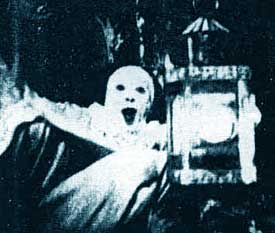 Taking off on a mid-19th Century Parisian pantomime theater piece, we get seven minutes (in the 1972 version) of the ghostly white clown Pierrot staggering about the stage, under a full moon, to the macabre pop tune "It Came in the Night." Oh, & there's a bunny, because of the Asian folktale that sees not a man-in-the-moon but a rabbit pounding rice.
Taking off on a mid-19th Century Parisian pantomime theater piece, we get seven minutes (in the 1972 version) of the ghostly white clown Pierrot staggering about the stage, under a full moon, to the macabre pop tune "It Came in the Night." Oh, & there's a bunny, because of the Asian folktale that sees not a man-in-the-moon but a rabbit pounding rice.
Rabbit's Moon is stunningly beautiful & apart from the pop tune could've been filmed in the silent era. Because the pop tune is so macabre, the innocent Pierrot, striving to capture the moon but failing utterly, becomes slightly sinister (as he often was at the Parisian pantomime, by the by).
Halfway through this short, Harlequin appears, Pierrot's classical nemesis dressed in motley. He swordfights, juggles, kneels, & seems slightly submissive to the ghostly innocent, though perhaps only trying to distract him from his lovesickness over the Moon.
At last appears Columbine, something of moth-girl herself attracted to the moonlight & to the light of a primitive projector (a Victorian "magic lantern"). She & Pierrot dance about in a lovely sort of way as Harlequin observes.
Critics unfamiliar with these standard pantomime characters have mistakenly thought Anger's influence was the kabuki theater, & Aleister Crowley via the tarot deck (seeing Harlequin as the Fool of tarot). Anger himself encouraged this belief that everything he did had Satanism as its underlying theme, but then Ken was fond of being shocking & wasn't necessarily often truthful. In Rabbit's Moon, fact is he hasn't varied any great distance from the basic form & content of a Pierrot legend.
I've always loved Pierrot & his support cast & Anger did nothing with them to offend that fondness. Certainly nothing Satanic or occult. The only person justifiably offended might have been Andy Arthurs who wrote "It Came in the Night," performed by his little known band A Raincoat, & grabbed by Kenneth Anger without permission.
An earlier version of this film exist, from 1950, was distributed with a doowop soundtrack, but I've not seen that one. A fifteen minute version (1976) has a completely different soundtrack including Mary Wells & others.
The first version was undertaken at a time when Anger was himself suicidal, which may account for the seriousness, gloom, & structure, not encountered in other Anger films.
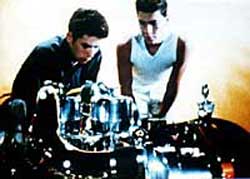 It occasionally seems that Anger's favorite color is red, as there's a lot of it in Puce Moment & quite a bit in Kustom Kar Commandos (1965). Red & blue. Anger films buff boys dusting a vintage car with a white fur dust-rag, while "Dream Lover" plays on the soundtrack. It occasionally seems that Anger's favorite color is red, as there's a lot of it in Puce Moment & quite a bit in Kustom Kar Commandos (1965). Red & blue. Anger films buff boys dusting a vintage car with a white fur dust-rag, while "Dream Lover" plays on the soundtrack.
Did Kenneth wack off to these little films or what? If so, it takes him three minutes to kustom kum.
It excuses its trivialness by being a scrap of an unpursued project. Because I liked the song as sung by the Paris Sisters, I inescapably liked the film Kenneth put with it. It's an MTV music video ahead of its time.
The last film by Kenneth Anger, Anger Sees Red (2004), shows that the dear filmmaker sustained pretty much the same vision throughout his life, getting no better & no worse as decades passed. In other words, still making amateur home movies, still tricking the world into taking a look-see at what it might be.
Starring the color red, we see a chap in a blue shirt & blue baseball cap walking down a pink street (thanks to camera filters). Discarding the shirt he takes a nap in the sun, but soon sits up & introduces himself as Red.
His missing blue shirt reappears & he goes for a walk looking at stop signs, because they're red, & walks past walls painted red, arriving home to look out the window with binoculars, presumedly at something red.
Imposing meaning on a Ken Anger film is like imposing meaning on a rock or a dried out seed pod or a turd. It is what it is. But I like fools' games so find it vaguely interesting that the title is Anger sees red, when it is actually the nameless young man & not the old fart filmmaker who is the point-of-view character seeing red. Then again this character's name is Red & in the process of directing the film, Anger saw him for the whole day's shoot. So it's a goofy little pun about Anger's interest in buff gents.
Not much to hang a film on, but at four & a half minutes my patience wasn't tested. I was amused.
copyright © by Paghat the Ratgirl
|
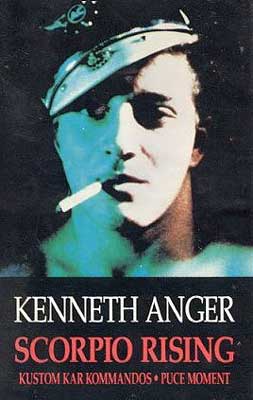
 Puce Moment (1949) starts out as the story of flapping fabric of dresses. They should've been worn by Ken himself; who would've known with mostly close-ups of cloth. But eventually we get to see the dancer's face & legs & she's quite a beauty hopping about in her boudoir.
Puce Moment (1949) starts out as the story of flapping fabric of dresses. They should've been worn by Ken himself; who would've known with mostly close-ups of cloth. But eventually we get to see the dancer's face & legs & she's quite a beauty hopping about in her boudoir.
 Anger casts himself as the horny young man who awakens from a dream or perhaps is still dreaming, & heads out on a violent quest for sexual satisfaction or achievement. Symbolism abounds like the doused torch that begins the film, the light seen in the men's can, as allusions to Lucifer not as Devil but as God of Enlightenment.
Anger casts himself as the horny young man who awakens from a dream or perhaps is still dreaming, & heads out on a violent quest for sexual satisfaction or achievement. Symbolism abounds like the doused torch that begins the film, the light seen in the men's can, as allusions to Lucifer not as Devil but as God of Enlightenment.


 We observe this young man at sundry half-mundane half-supernatural activities, until he takes a bath, sinks beneath the tub's water, & seemingly awakens as an androgynous ghostly woman in a tomb in a burning forest.
We observe this young man at sundry half-mundane half-supernatural activities, until he takes a bath, sinks beneath the tub's water, & seemingly awakens as an androgynous ghostly woman in a tomb in a burning forest.
